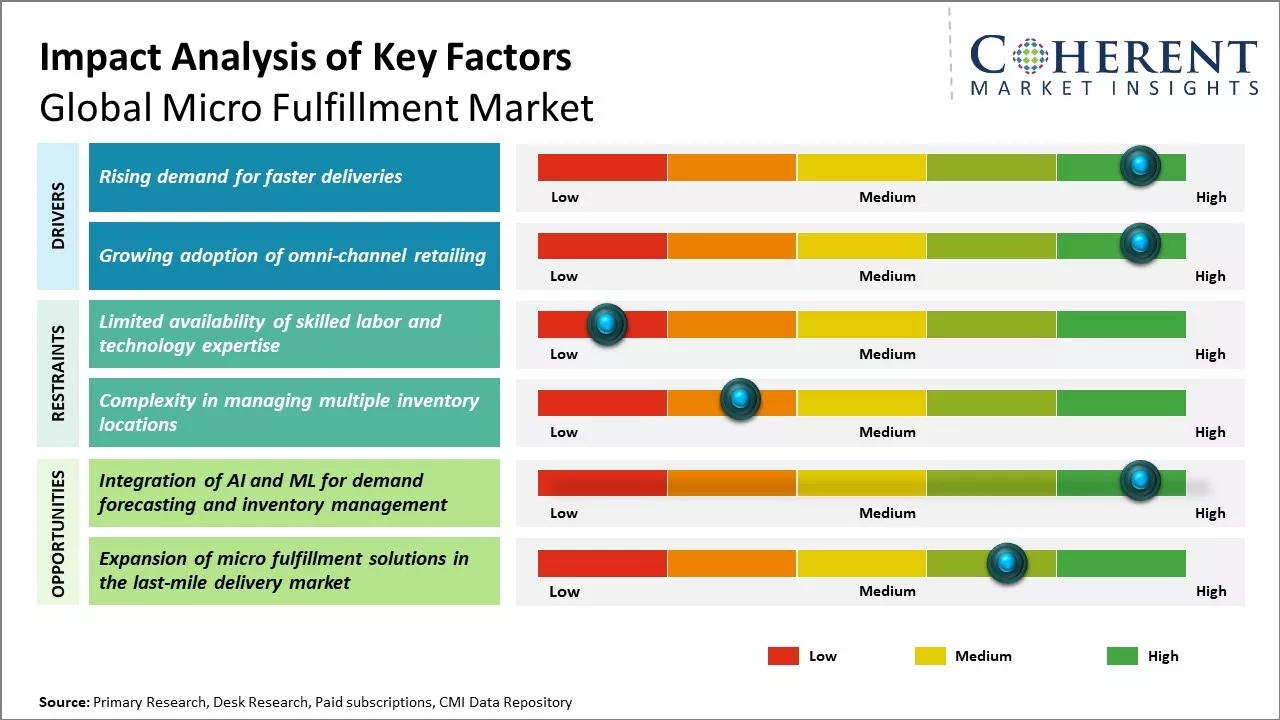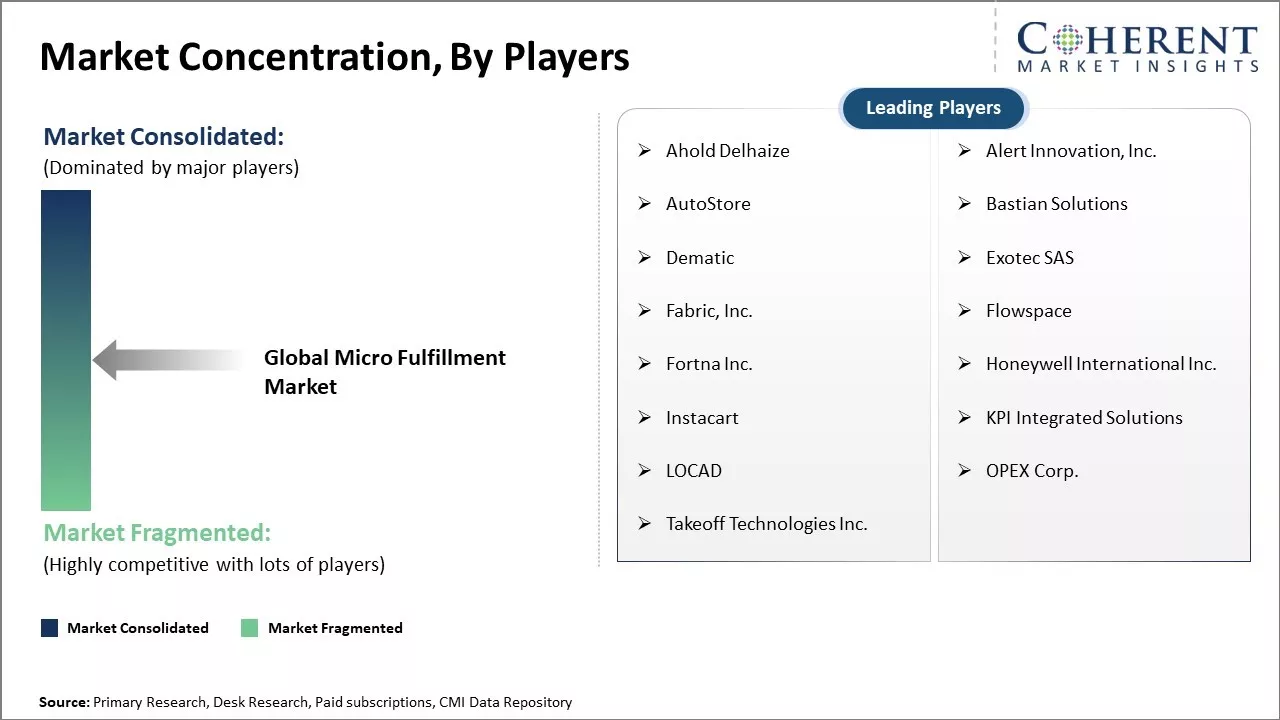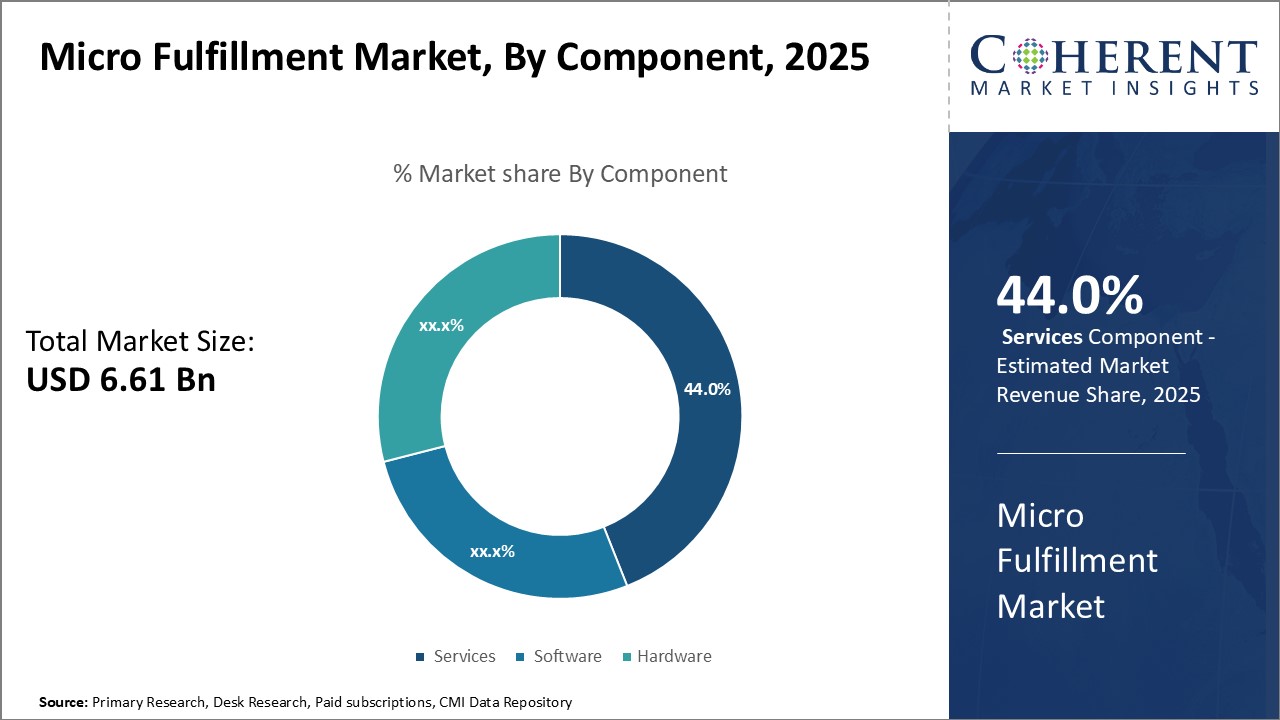Micro Fulfillment Market Size and Trends
Global micro fulfillment market is estimated to be valued at US$ 6.61 Bn in 2025 and is expected to reach US$ 53.25 Bn by 2032, exhibiting a compound annual growth rate (CAGR) of 34.7% from 2025 to 2032. Micro fulfillment is becoming an important part of omni-channel strategy for major retailers. The technology enables stores to operate distributed micro-fulfillment centers located close to the end consumer to offer faster delivery options.

Discover market dynamics shaping the industry: Download Free Sample
Growing demand for same-day delivery and tighter delivery timelines can boost adoption of micro fulfillment solutions by retailers and third-party logistics providers. Moreover, the trend towards automation and workforce optimization prompt organizations to explore micro fulfillment to improve operational efficiencies and provide better consumer experience.
Rising demand for faster deliveries
The surge in online shopping has significantly heightened consumer expectations regarding delivery speed. Today, customers increasingly demand rapid fulfillment, often seeking delivery within hours or by the end of the day. Traditional fulfillment models, which depend on centralized warehouses and regional distribution centers, struggle to meet these escalating demands for swift service.
To address this challenge, the implementation of micro fulfillment centers is becoming essential. These facilities, strategically located within a 5-10 mile radius of consumers, enable retailers to expedite order processing. By storing inventory closer to the customer, these micro fulfillment centers facilitate quicker picking, packing, and delivery, thereby enhancing the overall customer experience.
As consumer preferences shift towards convenience and immediacy, micro fulfillment is poised to play a crucial role in enabling retailers to deliver superior service. This approach not only aligns with the growing trend of same-day and even same-hour deliveries but also positions retailers to remain competitive in an increasingly demanding market.
Market Concentration and Competitive Landscape

Get actionable strategies to beat competition: Download Free Sample
Growing adoption of omni-channel retailing
Today's consumers exhibit a fluid approach to shopping, seamlessly transitioning between online and in-store channels. They may begin their purchasing journey with online research, then visit physical stores to evaluate products before completing their purchase online. Alternatively, they might choose to order online for home delivery but switch to in-store pickup if delivery options are inconvenient.
This intricate omnichannel behavior presents significant challenges for retailers using traditional models that treat online and physical channels separately. Micro fulfillment centers offer a solution by enabling retailers to provide a cohesive shopping experience across all platforms.
With inventory stored in micro fulfillment locations, retailers can efficiently fulfill both online orders and those placed for in-store pickup. Items can be picked from these micro centers and sent to physical stores for curbside collection or for customers to try before purchasing. This integrated fulfillment strategy enhances the omnichannel experience, which is essential for retailers aiming to meet the expectations of today’s empowered shoppers. By leveraging micro fulfillment, retailers can strengthen their omnichannel capabilities and better serve their customers in an increasingly competitive landscape.
Key Takeaways from Analyst:
Growing e-commerce industry along with rising demand for faster delivery of goods can boost adoption of micro fulfillment centers globally. The ability of micro fulfillment centers to fulfill orders at 10x the capacity of traditional warehouses provides a compelling value proposition to retailers and third-party logistics providers. Technological advancements in areas such as robotics, automation, artificial intelligence allows the development of smaller but highly efficient micro fulfillment centers.
North America currently dominates the micro fulfillment market. Strong economic growth and rising internet penetration can drive the market growth in Asia Pacific region particularly in China and India. The e-commerce revolution and growing consumer expectations of instant gratification in these densely populated developing countries can attract significant investments from logistics operators in building localized micro fulfillment infrastructure. The last-mile delivery challenge faced by online retailers in urban locations make micro fulfillment centers an attractive proposition.
Rising real estate and labor costs can pose challenges for the market growth. The high initial set up and technology adoption costs associated with micro fulfillment can also limit their adoption by small and medium sized retailers and third-party logistics companies.
Market Challenges: Limited availability of skilled labor and technology expertise
The limited availability of skilled labor and technology expertise can hamper the growth of micro fulfillment market. Micro fulfillment is an emerging technology that utilizes automated systems and robotics to pick, pack and ship items to customers from mini-warehouses located close to the point of consumption. However, setting up and operating such highly automated fulfillment centers requires a specialized workforce that has skills in robotics, automation, logistics operations and supply chain management.
Market Opportunities: Integration of AI and ML for demand forecasting and inventory management
The integration of artificial intelligence and machine learning for demand forecasting and inventory management presents a tremendous opportunity for the micro fulfillment market growth. AI and ML technologies have advanced rapidly, thus, allowing companies to analyze massive amounts of data and identify complex patterns. When applied to demand forecasting and inventory management for micro fulfillment services, AI and ML stand to deliver transformative benefits.
Through machine learning models that take thousands of data points as input including order histories, customer demographics, product details, pricing, seasons, trends, and more, companies can generate extremely accurate demand forecasts. This allows for precise booking of warehouse space and inventory levels right down to the SKU. Micro fulfillment providers will be able to very precisely predict spikes and lulls in demand, and proactively manage their inventory so the right products are in the right places at the right times. With AI taking over rote tasks, human workers can focus on strategic tasks like introducing new product lines, expanding to new regions, and ensuring optimal customer experience.

Discover high revenue pocket segments and roadmap to it: Download Free Sample
Insights By Component- Services Segment Dominate Due to Rising Demand for Streamlined Operations
In terms of component, services segment is expected to contribute the highest market share of 44.0% in 2025, due to growing demand from retailers and e-commerce companies for streamlined and efficient warehouse operations. Micro fulfillment solutions involve complex hardware and software systems that require extensive services throughout implementation and use. Professional services play a crucial role in designing customized solutions, installing equipment, integrating various technologies, and training staff on workflow management. Ongoing services are also important for maintenance and upgrades to ensure the micro fulfillment centers run smoothly and meet evolving business needs.
As micro fulfillment gain popularity due to advantages like space utilization and rapid order processing, more companies are turning to specialized services providers for strategic consulting and deployment of these high-tech solutions. There has been huge demand for experienced labor as proper integration between the facilities and existing operations requires an in-depth understanding of supply chains, inventory management, and robotics. Services providers help optimize floor plans, equipment selection, and processes to maximize throughput while maintaining accuracy. Their expertise minimizes disruption during transition and helps leverage the full capabilities of these advanced systems.
Post-implementation services are necessary to maximize ROI on micro fulfillment investments. Contracted support for maintenance, repairs, software updates and troubleshooting address issues before these impact business functions. Lifecycle services allow centers to keep pace with growing demand volumes and new product introductions. Analytics services use vast operational data from the centers to identify areas for efficiency gains or new revenue opportunities. This ensures the fulfillment solution continuously adapts and provides long-term competitive advantages for users.
Insights By Type - Store-Integrated Solutions Drive Growth
In terms of type, store-integrated/in store segment is expected to contribute the highest market share of 39.8% in 2025, due to the popularity of micro fulfillment centers located within existing retail footprints. Traditional retailers are under immense pressure to modernize supply chains as e-commerce reshapes customer expectations around delivery speed and omni-channel shopping experiences. Store-integrated micro fulfillment provides an efficient solution to address these challenges without requiring expensive new constructions.
Locating micro fulfillment centers in the backrooms of popular stores allows for quicker fulfillment of online orders from existing inventory. Groceries, consumer electronics and apparel retailers have especially adopted this model to enable in-store pickup of online orders within hours and meet demands for same-day delivery. The approach provides a worthwhile middle ground where e-commerce orders leverage store assets while maintaining stock solely for online fulfillment separately would be cost prohibitive. It streamlines fulfillment from current locations without wasting retail space or disrupting front-end operations.
Store-integrated micro fulfillment also facilitates buy-online-pickup-in-store (BOPIS) functionality and allows stores to accept returns of online orders. This drives additional foot traffic to physical stores while creating seamless omni-channel experiences. The combination of automated inventory visibility, picking and sorting technology within stores' existing footprints makes on-demand fulfillment highly profitable and customer-centric. Leading retailers continue advancing this low-risk model to better orchestrate their digital and physical operations.
Insights By Application- E-Commerce Accelerates Adoption
In terms of application, e-commerce segment is expected to contribute the highest market share of 41.4% in 2025, due to rapid growth of online ordering. As more consumers shift purchases to digital platforms, e-retailers and online marketplaces face mounting pressures around speed, selection and customer service. Legacy fulfillment methods struggle to economically meet rising service expectations across diverse product categories and delivery timeframe. Micro fulfillment addresses these issues through dedicated, automated facilities configured for each application’s specific fulfillment needs.
E-commerce companies turn to micro fulfillment centers for centralized hub sites to consolidate inventory and optimize multi-channel order processing. The software-directed units quickly pick, sort and dispatch shipments to vendors or customers from inventory pooled across regional warehouses or dark stores. These free up labor and space to focus on core capabilities while continuously scaling throughput to support peaks. The flexibility also boosts cross-selling through targeted assortments optimized for speed rather than size.
Dark stores, which hold merchandise solely for e-commerce orders, leverage micro fulfillment centers’ dense storage and goods-to-person robots. These fulfill hyper-local delivery within just hours in large metropolitan markets. Customized stations equip staff to rapidly process curbside, parcel shop or locker orders. The low-footprint model disperses inventory closer to population hubs for faster shipping at lower costs versus large centralized warehouses. E-commerce players are further deploying mobile micro centers through applications like automated parcel locker systems.
Regional Insights

Need a Different Region or Segment? Download Free Sample
North America dominates the global micro fulfillment market with an estimated market share of 40.9%in 2025. The U.S. market has witnessed huge demand for micro fulfillment solutions from major e-commerce retailers and third-party logistics providers. This can be attributed to higher retail e-commerce penetration and the presence of leading technology companies developing pioneering micro fulfillment technologies. Stores in dense urban areas are repurposing real estate to accommodate these distributed order fulfillment centers close to customers. Several large retailers have announced rollouts of dozens of micro-fulfillment facilities across major cities to enable one- or two-hour delivery promises.
An early tech hub for the development of warehouse robotics and automation, the region also boasts a strong base of systems integrators supporting micro fulfillment deployments. Homegrown technology providers have benefitted from local customer engagements to refine their solutions. With higher wages pushing the need for labor-cutting technologies, North American logistics operators have been receptive to micro fulfillment concepts that leverage robotics and artificial intelligence. The competitive e-commerce landscape has further spurred widespread experimentation with fulfillment technologies.
Asia Pacific region has emerged as the fastest growing market for micro fulfillment globally. Rapid e-commerce adoption in major Asian economies like China and India boosts demand for omnichannel fulfillment capabilities. Despite higher costs of real estate and labor compared to large centralized warehouses, prominent retailers are exploring micro fulfillment strategies to reduce delivery times, particularly in tier 1 cities. The import and export hub of Southeast Asia also contributes to the region’s expanding micro fulfillment market.
Market Report Scope
Micro Fulfillment Market Report Coverage
| Report Coverage | Details | ||
|---|---|---|---|
| Base Year: | 2024 | Market Size in 2025: | USD 6.61 Bn |
| Historical Data for: | 2020 To 2024 | Forecast Period: | 2025 To 2032 |
| Forecast Period 2025 to 2032 CAGR: | 34.7% | 2032 Value Projection: | USD 53.25 Bn |
| Geographies covered: |
|
||
| Segments covered: |
|
||
| Companies covered: |
Ahold Delhaize, Alert Innovation, Inc., AutoStore, Bastian Solutions, Dematic, Exotec SAS, Fabric, Inc., Flowspace, Fortna Inc., Honeywell International Inc., Instacart, KPI Integrated Solutions, LOCAD, OPEX Corp., and Takeoff Technologies Inc. |
||
| Growth Drivers: |
|
||
| Restraints & Challenges: |
|
||
Uncover macros and micros vetted on 75+ parameters: Get instant access to report
Micro Fulfillment Industry News
- In September 2023, P. Moller-Maersk, one of the world's largest container shipping companies, announced its plans to open a 38,000-square-foot automated e-Commerce fulfillment center in Dallas. The facility will leverage robotic and software technology from Fabric, a leading micro-fulfillment center (MFC) provider known for its innovative solutions that enable efficient and scalable order fulfillment for retailers and logistics companies.
- In February 2023, Fulfil, a startup specializing in robotic micro-fulfillment center (MFC) solutions designed to help grocers efficiently pick and pack e-Commerce orders, announced that it had secured US$ 60 million in its Series B funding round. This investment will enable Fulfil to enhance its innovative solutions, further supporting grocery retailers in meeting the growing demands of online shopping.
- In March 2022, Instacart, a leading online grocery delivery service that pioneered e-Commerce solutions for the grocery industry, launched key new fulfillment, advertising, and insights capabilities for retailers including Publix, ALDI, Schnuck Markets Inc., Good Food Holdings, Plum Market, Key Food, and Food Bazaar. This initiative aims to enhance the digital transformation of these retailers by providing them with advanced tools to improve their omnichannel customer experiences.
- In March 2021, Flowspace, a startup that provides on-demand warehousing and fulfillment solutions for businesses of all sizes, announced it had raised US$ 31 million in a Series B funding round. The investment was led by BuildGroup, a venture capital firm based in Austin, Texas, with participation from existing investors. Flowspace's proprietary software platform helps businesses manage their warehousing and fulfillment needs and is currently utilized in hundreds of partnering fulfillment centers across the U.S.
*Definition: Global Micro Fulfillment Market refers to the business of operating small warehouses equipped with automated systems that enable on-demand order fulfillment at a hyperlocal level. These micro-warehouses allow retailers and third-party logistics providers to store inventory closer to customers in urban and dense suburban areas to facilitate rapid delivery of orders within hours. Micro fulfillment centers use technologies like automated pickers, sorters and runners to efficiently pick, pack and ship online orders in a smaller footprint compared to traditional warehouses.
Market Segmentation
- Component Insights (Revenue, US$ Bn, 2020 - 2032)
- Hardware
- Software
- Services
- Type Insights (Revenue, US$ Bn, 2020 - 2032)
- Standalone
- Store-integrated/in Store
- Dark Stores
- Application Insights (Revenue, US$ Bn, 2020 - 2032)
- E-commerce
- Traditional Retailers & Distributors
- Manufacturers
- Regional Insights (Revenue, US$ Bn, 2020 - 2032)
- North America
- U.S.
- Canada
- Latin America
- Brazil
- Argentina
- Mexico
- Rest of Latin America
- Europe
- Germany
- U.K.
- Spain
- France
- Italy
- Russia
- Rest of Europe
- Asia Pacific
- China
- India
- Japan
- Australia
- South Korea
- ASEAN
- Rest of Asia Pacific
- Middle East & Africa
- GCC Countries
- Israel
- South Africa
- Rest of Middle East & Africa
- North America
- Key Players Insights
- Ahold Delhaize
- Alert Innovation, Inc.
- AutoStore
- Bastian Solutions
- Dematic
- Exotec SAS
- Fabric, Inc.
- Flowspace
- Fortna Inc.
- Honeywell International Inc.
- Instacart
- KPI Integrated Solutions
- LOCAD
- OPEX Corp.
- Takeoff Technologies Inc.
Share
Share
About Author
Ankur Rai is a Research Consultant with over 5 years of experience in handling consulting and syndicated reports across diverse sectors. He manages consulting and market research projects centered on go-to-market strategy, opportunity analysis, competitive landscape, and market size estimation and forecasting. He also advises clients on identifying and targeting absolute opportunities to penetrate untapped markets.
Missing comfort of reading report in your local language? Find your preferred language :
Transform your Strategy with Exclusive Trending Reports :
Frequently Asked Questions
EXISTING CLIENTELE
Joining thousands of companies around the world committed to making the Excellent Business Solutions.
View All Our Clients
